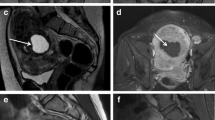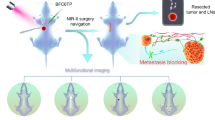Abstract
Purpose
With the availability of near-infrared fluorescence (NIRF) imaging using indocyanine green dye (ICG) to the robotic platform, utility of this imaging technology has evolved significantly across the board for ablative and reconstructive procedures. Herein, we describe the potential indications of indocyanine green for both oncologic and non-oncologic applications in robot-assisted laparoscopic urologic surgery.
Methods
A narrative mini-review was performed in November 2018 using PubMed, Scopus, EMBASE, and Web of Science databases utilizing the following search phrase: “indocyanine green fluorescence robotic surgery” resulting in 104 articles of which 30 articles had urologic-pertinent applications. All 30 articles, and the references within, were reviewed and judged for scientific integrity and merit. Articles with non-novel findings or similar conclusions to original papers were omitted.
Results
ICG does not have a urologic FDA indication, though it has been used off-label for urologic surgery since 2006. Fluorescence-augmented surgery with ICG can facilitate oncologic surgery in the adrenal gland, kidney, bladder, prostate, and retroperitoneum, in addition to lymph node dissection for various malignant pathologies. ICG-NIRF can enhance non-oncologic surgery including ureterolysis, ureteroureterostomy, ureteral re-implantation, pyeloplasty, and urinary diversion in both the adult and pediatric populations.
Conclusions
Although it is not necessary to utilize fluorescence-enhanced surgery in all cases, the authors find the utilization of ICG-NIRF in complex and highly technical surgeries useful.
Similar content being viewed by others
References
Gioux S, Choi H, Frangioni J (2010) Image-guided surgery using invisible near-infrared light: fundamentals of clinical translation. Mol Imaging 9:237–255
van den Berg N, van Leeuwen F, ven der Poel H (2012) Fluorescence guidance in urologic surgery. Curr Opin Urol 22:109–120
NDA 011525. Food and Drug Administration SUPPL-27 Labeling-Packaging insert
Tobis S, Knopf J, Silvers C et al (2012) Near infrared fluorescence imaging after intravenous indocyanine green: initial clinical experience with open partial nephrectomy for renal cortical tumors. Urology 79:958–964
Tobis S, Knopf J, Silvers C et al (2012) Robot-assisted and Laparoscopic Partial Nephrectomy with Near Infrared Fluorescence Imaging. J Endourol 26:797–802
Manny T, Patel M, Hemal A (2014) Fluorescence-enhanced robotic radical prostatectomy using real-time lymphangiography and tissue marking with percutaneous injection of unconjugated indocyanine green: the initial clinical experience in 50 patients. Eur Urol 65:1162–1168
Manny T, Hemal A (2014) Fluorescence-enhanced robotic radical cystectomy using unconjugated indocyanine green for pelvic lymphangiography, tumor marking, and mesenteric angiography: the initial clinical experience. Urology 83:824–829
Manny T, Pompeo A, Hemal A (2013) Robotic partial adrenalectomy using indocyanine green dye with near-infrared imaging: the initial clinical experience. Urology 82:738–742
IC-green (indocyanine green). http://www.pdr.net. Retrieved Feb 2019
Bjurlin M, McClintock T, Stifelman M (2015) Near-infrared fluorescence imaging with intraoperative administration of indocyanine green for robotic partial nephrectomy. Curr Urol Rep 16:1–7
Krane L, Manny T, Hemal A (2012) Is near infrared fluorescence imaging using indocyanine green dye useful in robotic partial nephrectomy: a prospective comparative study of 94 patients. Urology 80:110–116
Arora S, Rogers C (2018) Partial nephrectomy in central renal tumors. J Endourol 32:63–67
Angell J, Khemees T, Abaza R (2013) Optimization of near infrared fluorescence tumor localization during robotic partial nephrectomy. J Urol 190:1668–1673
Manny T, Krane L, Hemal A (2013) Indocyanine green cannot predict malignancy in partial nephrectomy: histopathologic correlation with fluorescence pattern in 100 patients. J Endourol 27:918–921
Borofsky M, Gill I, Hemal A et al (2012) Near-infrared fluorescence imaging to facilitate super-selective arterial clamping during zero-ischemia robotic partial nephrectomy. BJU Int 111:604–610
Sound S, Okoh A, Bucak E et al (2016) Intraoperative tumor localization and tissue distinction during robot adrenalectomy using indocyanine green fluorescence imaging: a feasibility study. Surg Endosc 30:657–662
Colvin J, Zaidi N, Berber E (2016) The utility of indocyanine green fluorescence imaging during robotic adrenalectomy. J Surg Oncol 114:153–156
Lee M, Lee Z, Eun D (2015) Intraureteral and intravenous indocyanine green to facilitate robotic partial nephroureterectomy in a patient with complete ureteral triplication. Korean J Urol 56:473–476
Pathak RA, Hemal AK (2018) Utilization of fluorescence-enhanced molecular imaging in robot-assisted uro-oncologic surgery. Videourology. https://doi.org/10.1089/vid.2018.0030
Ramirez-Backhaus M, Moreno A, Ferrer A et al (2016) Indocyanine green guided pelvic lymph node dissection: an efficient technique to classify the lymph node status of patients with prostate cancer who underwent radical prostatectomy. J Urol 196:1429–1435
Kumar A, Tandon S, Samavedi S et al (2016) Current status of various neurovascular bundle-sparing techniques in robot-assisted radical prostatectomy. J Robot Surg 10:187–200
Patel MN, Hemal AK (2016) Molecular targeted fluorescence-guided intraoperative imaging of bladder cancer nodal drainage using indocyanine green during radical and partial cystectomy. Curr Urol Rep 17:74
Morales-Bermudez A (2015) Fluorescence imaging technology for robotic assisted partial cystectomy and ureteral reconstruction minimizes lack of tactile feedback. Eur Urol Suppl 14:980
Xia L, Venegas O, Predina J et al (2016) Intraoperative molecular imaging for post-chemotherapy robot-assisted laparoscopic resection of seminoma metastasis: a case report. Clin Genitourin Cancer 15:61–64
Hemal A, Nayyar R, Gupta N et al (2010) Experience with robot-assisted laparoscopic surgery for upper and lower benign and malignant ureteral pathologies. Urology 76:1387–1393
Lee Z, Simhan J, Parker D et al (2013) Novel use of indocyanine green for intraoperative, real-time localization of ureteral stenosis during robot-assisted ureteroureterostomy. Urology 82:729–733
Autorino R, Eden C, El-Ghoneimi A et al (2014) Robot-assisted and laparoscopic repair of ureteropelvic junction obstruction: a systematic review and meta-analysis. Eur Urol 65:430–452
Lee Z, Moore B, Giusto L et al (2015) Use of indocyanine green during robot-assisted ureteral reconstruction. Eur Urol 67:291–298
Arichi N, Mitsui Y, Ogawa T et al (2014) Intraoperative fluorescence vascular imaging using indocyanine green for assessment of transplanted kidney perfusion. Transplant Proc 46:342–345
Siddighi S, Yune J, Hardesty J (2014) Indocyanine green for intraoperative localization of ureter. Am J Obstet Gynecol 436e:1–2
Chopra S, de Castro Abreu A, Berger A et al (2016) Evolution of robot-assisted orthotopic ileal neobladder formation: a step-by-step update to the University of Southern California (USC) technique. BJU Int 119:185–191
van den Berg N, Buckle T, KleinJan G et al (2017) Multispectral fluorescence imaging during robot-assisted laparoscopic sentinel node biopsy: a first step towars a fluorescence-based anatomic roadmap. Eur Urol 72:110–117
Nakajima T, Mitsunaga M, Bander N et al (2012) Targeted, activatable, in vivo fluorescence imaging of prostate-specific membrane antigen (PSMA)-positive tumors using the quenched humanized J591 antibody-ICG conjugate. Bioconjung Chem 22:1700–1705
Pathak RA, Hemal AK (2018) Developing a personalized template for lymph node dissection during radical prostatectomy. TAU. https://doi.org/10.21037/tau2018.03.19
Author information
Authors and Affiliations
Corresponding author
Ethics declarations
Conflict of interest
Ram Pathak and Ashok Hemal declare that they have no conflict of interest.
Research involving human participants and/or animals
This article does not contain any studies with human participants performed by any of the authors.
Additional information
Publisher’s Note
Springer Nature remains neutral with regard to jurisdictional claims in published maps and institutional affiliations.
Rights and permissions
About this article
Cite this article
Pathak, R.A., Hemal, A.K. Intraoperative ICG-fluorescence imaging for robotic-assisted urologic surgery: current status and review of literature. Int Urol Nephrol 51, 765–771 (2019). https://doi.org/10.1007/s11255-019-02126-0
Received:
Accepted:
Published:
Issue Date:
DOI: https://doi.org/10.1007/s11255-019-02126-0




